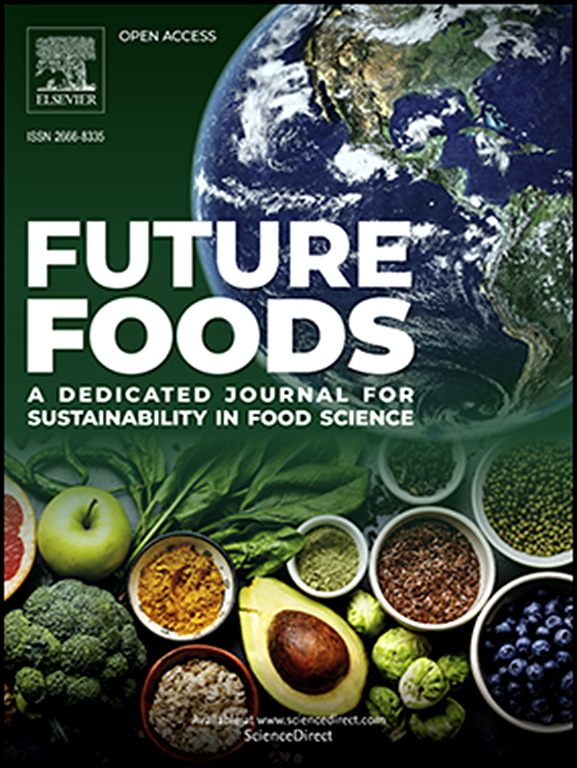使用含有从枇杷(Eriobotrya japonica)种子中提取的多糖的可食用涂层提高鳟鱼鱼片的保质期
IF 8.2
Q1 FOOD SCIENCE & TECHNOLOGY
引用次数: 0
摘要
本研究旨在评价枇杷籽多糖可食性包衣对鳟鱼鱼片冷藏12 d后微生物、化学和感官品质的影响。经540 W微波处理15 min,多糖收率最高(48.2%)。该提取物具有显著的抗氧化性能,包括57%的2,2-二苯基-1-picrylhydrazyl (DPPH)和64%的羟基自由基(HO)清除活性,以及强的铁还原抗氧化能力(700 nm吸光度为0.7),表明其具有良好的延缓氧化变质的潜力。为制备包被,分别测定了明胶与枇杷籽多糖的不同配比(G1-P0, G1-P0.5, G1-P1)。多糖含量的增加导致贮藏过程中总细菌和嗜冷细菌的生长速率显著降低。此外,多糖浓度越高,pH值越低。含有更多多糖的样品还显示出化学变质指标水平的降低,包括过氧化值(PV)、硫代巴比妥酸活性物质(TBA)、游离脂肪酸(FFA)、总挥发性碱性氮(TVB-N)和三甲胺(TMA),所有这些都是已知的鳟鱼鱼片脂质氧化和蛋白质降解的标志物。感官评价证实,与未涂覆的样品相比,涂覆了富含多糖配方的鱼片在气味、颜色和总体可接受性方面得分明显更高。本研究介绍了枇杷籽多糖在食用涂料中的新应用,与传统的明胶基涂料相比,枇杷籽多糖在鳟鱼鱼片上的防腐效果更好。本文章由计算机程序翻译,如有差异,请以英文原文为准。

Enhanced shelf life of trout fillets using an edible coating containing the polysaccharide extracted from Loquat (Eriobotrya japonica) seed
This study aimed to evaluate the effect of an edible coating enriched with polysaccharides extracted from loquat (Eriobotrya japonica) seeds on the microbial, chemical, and sensory quality of trout fillets during 12 days of cold storage. The highest polysaccharide yield (48.2 %) was achieved by applying microwave treatment at 540 W for 15 min. The extract exhibited remarkable antioxidant properties, including 57 % 2,2-diphenyl-1-picrylhydrazyl (DPPH) and 64 % hydroxyl radical (HO) scavenging activity, as well as strong ferric reducing antioxidant power (0.7 absorbance at 700 nm), suggesting its excellent potential to delay oxidative spoilage. To formulate the coating, different ratios of gelatin and loquat seed polysaccharide were tested (G1-P0, G1-P0.5, and G1-P1). Increasing the polysaccharide content resulted in a significant reduction in the growth rate of total and psychrophilic bacteria during storage. Moreover, lower pH values were observed in treatments with higher polysaccharide concentrations. Samples with more polysaccharide also showed reduced levels of chemical spoilage indicators, including peroxide value (PV), thiobarbituric acid reactive substances (TBA), free fatty acids (FFA), total volatile basic nitrogen (TVB-N), and trimethylamine (TMA), all of which are known markers of lipid oxidation and protein degradation in trout fillets. Sensory evaluations confirmed that fillets coated with polysaccharide-rich formulations had significantly better scores in odor, color, and overall acceptability compared to uncoated samples. This study introduces a novel application of loquat seed polysaccharides in edible coatings, offering enhanced preservative effects compared to traditional gelatin-based coatings for trout fillets.
求助全文
通过发布文献求助,成功后即可免费获取论文全文。
去求助
来源期刊

Future Foods
Agricultural and Biological Sciences-Food Science
CiteScore
8.60
自引率
0.00%
发文量
97
审稿时长
15 weeks
期刊介绍:
Future Foods is a specialized journal that is dedicated to tackling the challenges posed by climate change and the need for sustainability in the realm of food production. The journal recognizes the imperative to transform current food manufacturing and consumption practices to meet the dietary needs of a burgeoning global population while simultaneously curbing environmental degradation.
The mission of Future Foods is to disseminate research that aligns with the goal of fostering the development of innovative technologies and alternative food sources to establish more sustainable food systems. The journal is committed to publishing high-quality, peer-reviewed articles that contribute to the advancement of sustainable food practices.
Abstracting and indexing:
Scopus
Directory of Open Access Journals (DOAJ)
Emerging Sources Citation Index (ESCI)
SCImago Journal Rank (SJR)
SNIP
 求助内容:
求助内容: 应助结果提醒方式:
应助结果提醒方式:


